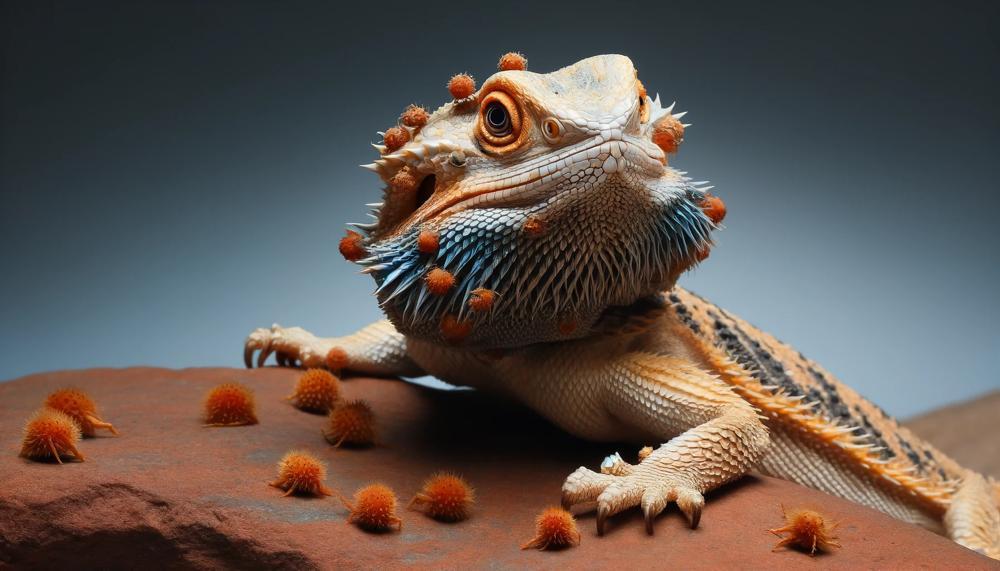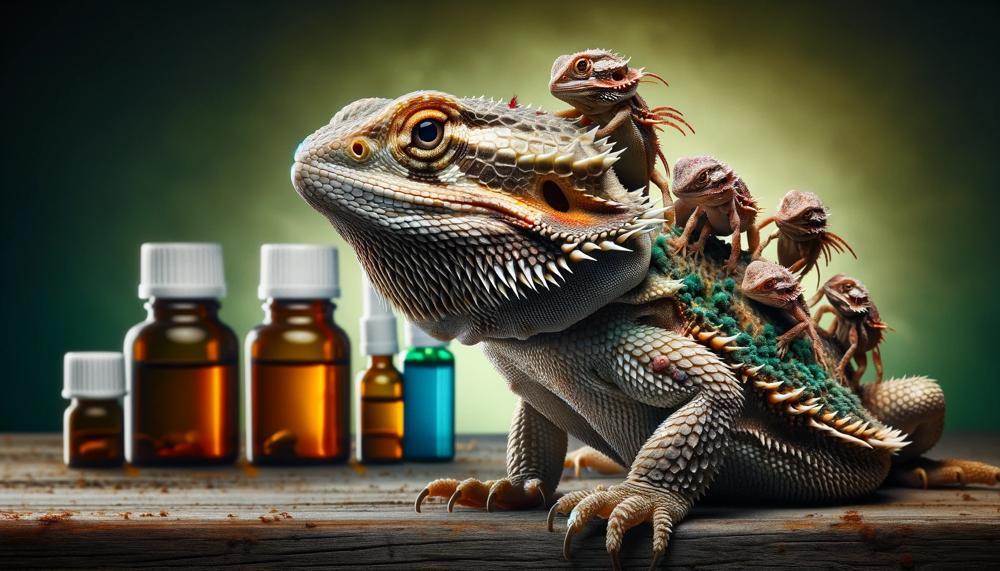Did you know that more than 70% of bearded dragons may carry potentially harmful bacteria like Salmonella without showing any symptoms? This shocking fact sheds light on an often-overlooked aspect of pet ownership that could have major health effects on people who aren’t knowledgeable about reptiles. In this post, we’ll look into the hidden dangers of these popular pets, showing how something as harmless as a lizard’s lick can cause serious health problems.
So, do bearded dragons carry diseases?
Yes, bearded dragons can carry diseases that can potentially be transmitted to humans. These illnesses may be bacterial, viral, or parasitic, and they can affect humans even if the bearded dragon appears healthy.
Whether you’re a current or prospective bearded dragon owner, recognizing these hazards and knowing how to handle them can make a world of difference to your and your pet’s health. Let’s explore these critical insights together, ensuring your interaction with your scaly friend is both enjoyable and safe.
Contents
Key Takeaways
When it comes to understanding the health risks associated with bearded dragons, there are several key takeaways that every current or prospective owner should keep in mind. These creatures, with their placid demeanor and distinctive looks, bring joy to many.
However, they can also carry pathogens that may pose health risks to humans and other pets. Here’s what you need to remember:
| Disease/Condition | Description | Impact on Humans/Pets |
| Salmonella | A bacterial infection that often doesn’t affect the reptile visibly but can be shed through their faeces. | Can cause food poisoning in humans, particularly dangerous for young children or those with compromised immune systems. |
| Parasites (Pinworms, Roundworms, Coccidia) | Internal parasites that can lead to health issues like weight loss and diarrhoea in bearded dragons. | Potentially transmissible to humans through contact with contaminated surfaces or faeces, causing digestive disturbances. |
| Respiratory Infections | Caused by bacteria such as Mycoplasma and Pseudomonas, leading to symptoms like wheezing and nasal discharge. | While not directly transmissible to humans, can spread to other reptiles and indicates poor habitat conditions. |
| Fungal Infections (e.g., Ringworm) | Contagious infections that affect the skin, can be spread through direct contact. | Highly transmissible to humans, causing skin rashes or lesions. |
| Zoonotic Diseases | Diseases that can be transmitted from animals to humans, though less common in bearded dragons. | Requires good hygiene practices to prevent potential transmission. |
To stave off these health risks, here are a few practical steps:
- Hygiene First: Always wash your hands thoroughly with soap and water after handling your bearded dragon or any of its accessories.
- Regular Vet Checks: Take your bearded dragon for routine vet visits to monitor for any signs of disease or parasites.
- Clean Living Space: Maintain a clean and hygienic environment for your pet by regularly cleaning and disinfecting its habitat.
- Educate Yourself and Others: Understanding and educating others about the risks can help prevent disease transmission.
In essence, while bearded dragons make for captivating pets, it’s paramount for owners to be vigilant about these potential health risks.
Health Risks from Bearded Dragons
Bearded dragons, those rugged and inquisitive mates from down under, are popular pets for a slew of reasons. But just like any pet, they’ve got their share of health niggles that can catch them—and sometimes their owners—off guard.
Understanding these ailments and knowing how to either dodge or deal with them can make a world of difference in keeping your scaly friend chipper and healthy. Here’s a dive into the most common diseases that can trouble bearded dragons, alongside some straightforward advice on prevention and treatment.
Common Diseases in Bearded Dragons
| Disease | Prevention | Treatment |
| Metabolic Bone Disease (MBD) | Ensure a balanced diet high in calcium and vitamin D3; UVB lighting. | Veterinary prescribed supplements; UVB lighting adjustments. |
| Infectious Stomatitis (Mouth Rot) | Maintain proper enclosure cleanliness; regular oral health checks. | Antibiotics and cleaning of the affected areas by a vet. |
| Upper Respiratory Infections (URI) | Avoid chilly or overly moist enclosure conditions. | Adjustment to enclosure conditions; antibiotics if bacterial. |
| Adenovirus | Isolate affected individuals to prevent spread. | Supportive care; no known cure. |
| Impaction | Avoid feeding oversized or hard-to-digest items; proper substrate. | Warm baths; possible veterinary intervention. |
| Prolapse | Proper diet to avoid constipation; correct handling. | Immediate veterinary treatment to reposition or surgically fix. |
Keeping Your Dragon Fighting Fit
- Light it right: UVB light is non-negotiable for these blokes. It helps them synthesise vitamin D3, crucial for absorbing calcium and preventing MBD.
- Diet dos and don’ts: A balanced diet, rich in calcium, is your best bet against many health issues. Dust their grub with calcium supplements and ensure they get a mix of greens and proteins.
- Clean as a whistle: Keep their crib spotless. Regular cleaning reduces the risk of infections and diseases.
- Quarantine new arrivals: New pets should be kept separate until you’re sure they’re disease-free, especially to prevent the spread of adenovirus.
In the end, a stitch in time saves nine. Paying attention to your bearded dragon’s environment, diet, and behaviour can help you catch issues before they become serious.
What can my Bearded Dragon Make Me Sick With?
Bearded dragons, charming as they are, can unwittingly pass on a few ailments to us humans. Let’s cut to the chase, folks; you’re here to suss out what illnesses these critters might hand over, right?
First off, there’s the infamous Salmonella, a tricky bugger that lurks in the dragon’s guts without much fuss but can turn our stomachs into a battlefield. Then, there’s the specialized version, Reptile-associated Salmonellosis (RAS), which sounds like something out of a science fiction novel but is very real and quite nasty, leading to severe conditions like meningitis or sepsis in vulnerable humans.
And let’s not overlook those pesky parasites. Bearded dragons can host a mini menagerie of these unwanted guests like coccidia, pinworms, and tapeworms, which can hitch a ride to our system, causing a right old mess in the gut.
But hey, don’t let this scare you off. With a bit of know-how and good hygiene, these risks can be significantly minimized. Regular hand washing, thorough cleaning of their digs, and proper handling can keep these risks at bay. Especially for the little ones or those with a frail health shield, extra care is needed.
Here’s a breakdown in a table to give you the gist:
| Illness | Source | Impact on Humans |
| Salmonellosis | Feces, saliva, skin | Diarrhea, fever, abdominal pain |
| Reptile-associated Salmonellosis (RAS) | Feces, environment | Meningitis, sepsis |
| Parasitic infections (e.g., coccidia, pinworms, tapeworms) | Feces, contaminated soil | Gastrointestinal issues |
So, while beardies can be a source of illness, a stitch in time, as they say, saves nine.
Can I Make My Bearded Dragon Sick?
Yes, we can unintentionally make their bearded dragons sick. Contagions like bacteria or even stress caused by mishandling can adversely affect your bearded friend. To ensure your bearded dragon stays healthy, follow these tips:
| Aspect | Action | Reason |
| Hygiene | Wash hands before/after handling | Prevent microbial transfer |
| Handling | Gentle, restricted roaming | Reduce stress and contamination |
| Environment | Clean, regulate habitat | Optimal living conditions |
| Diet | Provide varied, healthy food | Ensure proper nutrition |
| Healthcare | Regular vet visits | Early detection and prevention |
Doctor’s Tips on Good Hygiene Practices
Here’s a concise guide on maintaining a healthy environment for these reptiles:
Enclosure Cleaning
| Frequency | Method | Notes |
| Weekly | Clean with reptile-safe disinfectant | Focus on removing shed skin, a hotbed for germs |
| As Needed | Spot clean feces or food remnants | Prevents bacterial growth and odor |
Hand Hygiene
| When | Action | Reason |
| Before/After Handling | Wash hands with soap | Reduces Salmonella risk |
| During Cleaning | Wear designated gloves | Minimizes cross-contamination |
Handling Techniques
- Gentleness is key: Avoid rough play to prevent scratches/bites.
- Separate Handling: If owning multiple dragons, wash hands in between.
Nutritional Care
- Diet: Fresh, pesticide-free vegetables, fruits, and insects.
- Cleanliness: Wash their food and water bowls after each use.
Veterinary Care and Quarantine
- Regular Check-ups: Schedule routine visits for overall health monitoring.
- New Arrivals: Quarantine new dragons for at least 30 days to monitor for adenovirus and other diseases.

Preventing Respiratory Infections
- Humidity Control: Keep the enclosure’s humidity at optimal levels.
- Stress-free Environment: A calm setting aids in preventing infections.
Managing Parasites
- Fecal Exams: Conduct regular checks for internal and external parasites.
- Clean Enclosure: Regular cleaning reduces parasite infestation chances.
Preventing Metabolic Bone Disease (MBD)
- Balanced Diet: Ensure a diet rich in calcium and vitamin D.
- UV Lighting: Provide adequate UVB lighting for vitamin D synthesis.
Overall Cleanliness
- Disinfect Accessories: Regularly sanitize rocks, branches, and other decor.
- Floor Substrate: Choose easy-to-clean substrates to reduce disease risks.
References and further reading
Certainly. Diving into the realm of bearded dragon care, especially understanding their potential diseases, is a noble quest. Here’s a curated list of reliable sources that will arm you with the knowledge you need to keep your scaly companion thriving:
| Source | Description | Website |
| Association of Reptilian and Amphibian Veterinarians (ARAV) | A professional group with a treasure of articles and resources on reptile health, including that of bearded dragons. | arav.org |
| Journal of Herpetological Medicine and Surgery | Peer-reviewed studies offering deep dives into reptile health issues, including those affecting bearded dragons. | jherpmedsurg.com |
| Journal of Exotic Pet Medicine | Another reputable, peer-reviewed journal packed with research and insights into exotic pet care, including bearded dragons. | journalofexoticpetmedicine.com |
| Reptiles Magazine | Offers a wide range of articles on reptile care, penned by seasoned experts in the field. | reptilesmagazine.com |
| ReptileCare.com | A hub for in-depth articles and forums where you can interact with other reptile enthusiasts and experts. | reptilecare.com |
Remember, while these sources are packed with wisdom, they’re not a substitute for professional veterinary care. If your bearded dragon shows signs of distress or illness, a vet visit is paramount.
Conclusion
When you decide to pet a bearded dragon, you take on a lot of responsibility, especially when it comes to knowing and dealing with the health risks these unique pets may pose. Although bearded dragons seem calm, they are actually carrying germs like Salmonella that can make people very sick, especially those with weak immune systems, without showing any clear signs in the lizards themselves. This hidden threat makes it even more important to take good care of yourself and be clean.
To keep from spreading germs, pet owners should make cleaning a priority and wash their hands after touching their pet or its environment on a regular basis. Taking your pet to the vet regularly and keeping the area around them clean are the most important things you can do to stop the spread of disease. To protect both human and animal health, it is also important to learn about the unique health risks and how to avoid them.
Disease spread is much less likely to happen if people are aware of the risks and take precautions.






